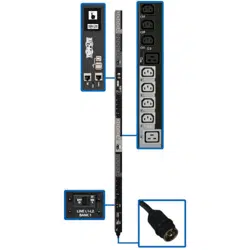Loading ...
Loading ...
Loading ...

30
4. Telnet/SSH Console
Most of the monitoring and control features available in the Web interface (see Section 3. The Web Interface) are also available in the Telnet
and/or SSH console. Accessing the LX Platform device through the Telnet/SSH console is ideal for mobile or resource-limited platforms.
Each menu can be thought of as one of four types: navigation, summary, detail and data collection.
Navigation Menus
Navigational menus allow a user to choose a path down the menu structure. Any data presented on these navigational menus are for information
only and will require continuing down into a submenu to make any modifications.
Summary Menus
Data items that can have multiple instances will also have a summary menu. For example, the Email Recipients will have a summary menu. The
summary will display a row for each member with a subset of the data for that object.
From the summary, a user may enter an ID number from the list to view/modify the detail menu for that item. If insert is allowed for the data,
the user will be presented with the option to enter ‘0’ as well. When ‘0’ is chosen, the user is then automatically prompted to enter the individual
detail menu items. Once all items have been entered, the user will be prompted to save the information, view the information, or abort the insert.
Detail Menus
The detail menus display the information about a collection of related individual data items. An example of a detail menu would be the menu for a
single Email Recipient. From the detail menu, a user will be given the option to choose to modify the individual data items. When allowed, deletes
will be done from the detail menus.
Some detail menus will immediately update the data as entered. Others will collect all the data changes and require the user to explicitly save
the data in one operation. Those that require an explicit save will present an ‘A’ option to apply the changes. If a user has pending changes and
attempts to leave the menu, an indication that the changes have not been saved will be presented and give the user the option to save or abort
the changes.
Data Collection Menus
Data collection menus allow a user to enter values for an individual data item. For example, the menu to update an Email Recipient’s email
address would be a data collection menu. These menus do not have any submenus.
Menu Permissions
The menu descriptions in this documentation will assume that the user has Read/Write permissions to all of the data. Not all users will have this
level of authorization.
The data displayed and the options presented to a given user will depend upon that user’s permissions. A user will only be presented with data
and options to the data that he or she is allowed to access. A more detailed discussion of user permissions can be found in the discussion on
Local User definitions later in this document.
Note: The menu examples were generated using one specific device model. Because the content of many of the device-specific menus will vary based upon the
device and protocol, these are simply examples to give an idea of the type of data displayed here and how it is formatted. The contents of these menus should not
necessarily be expected to be displayed, unless it is explicitly stated that the setting applies for all device types.
Menus
Main Menu
The main menu is the starting menu when a user accesses the Telnet/SSH interface. It contains the entry point for all of the pieces of the system
data. All other menus are accessible from the main menu.
To help keep the user informed about active alarms, the current list of active alarms is always displayed as part of the main menu.
Tripp Lite (c) Copyright 2005-2018
PowerAlert 15.5.2 (Build 17511) All Rights Reserved
--------------------------------------------------------------------------------
-------- ALARMS ----------------------------------------------------------------
No active alarms present
-------- Main Menu -------------------------------------------------------------
1- Devices
2- System Configuration
3- Network Configuration
4- Alarms and Logging
5- About
E- Launch CLI
Q- Logout
<ENTER> Refresh Menu
Loading ...
Loading ...
Loading ...
